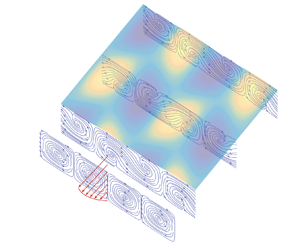Article contents
Stability analysis of open-channel flows with secondary currents
Published online by Cambridge University Press: 29 September 2021
Abstract

This paper presents some results coming from a linear stability analysis of turbulent depth-averaged open-channel flows (OCFs) with secondary currents. The aim was to identify plausible mechanisms underpinning the formation of large-scale turbulence structures, which are commonly referred to as large-scale motions (LSMs) and very-large-scale motions (VLSMs). Results indicate that the investigated flows are subjected to a sinuous instability whose longitudinal wavelength compares very well with that pertaining to LSMs. In contrast, no unstable modes at wavelengths comparable to those associated with VLSMs could be found. This suggests that VLSMs in OCFs are triggered by nonlinear mechanisms to which the present analysis is obviously blind. We demonstrate that the existence of the sinuous instability requires two necessary conditions: (i) the circulation of the secondary currents  $\omega$ must be greater than a critical value
$\omega$ must be greater than a critical value  $\omega _c$; (ii) the presence of a dynamically responding free surface (i.e. when the free surface is modelled as a frictionless flat surface, no instabilities are detected). The present paper draws some ideas from the work by Cossu, Hwang and co-workers on other wall flows (i.e. turbulent boundary layers, pipe, channel and Couette flows) and somewhat supports their idea that LSMs and VLSMs might be governed by an outer-layer cycle also in OCFs. However, the presence of steady secondary flows makes the procedure adopted herein much simpler than that used by these authors.
$\omega _c$; (ii) the presence of a dynamically responding free surface (i.e. when the free surface is modelled as a frictionless flat surface, no instabilities are detected). The present paper draws some ideas from the work by Cossu, Hwang and co-workers on other wall flows (i.e. turbulent boundary layers, pipe, channel and Couette flows) and somewhat supports their idea that LSMs and VLSMs might be governed by an outer-layer cycle also in OCFs. However, the presence of steady secondary flows makes the procedure adopted herein much simpler than that used by these authors.
- Type
- JFM Papers
- Information
- Copyright
- © The Author(s), 2021. Published by Cambridge University Press
References
REFERENCES
- 6
- Cited by



